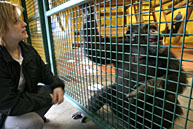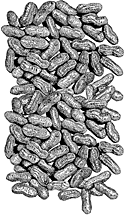Kaleidoscope
Arryn Ketter: Sympathy for simians
 Photo: Owen Egan
Photo: Owen Egan |
|
Evolutionary experts have long believed that humans are related to apes. Arryn Ketter, a second-year McGill law student, takes the theory further.
"They're family," she says.
But Ketter speaks from personal experience rather than an evolutionary perspective. She's referring to the 14 chimpanzees that she cares for at the Fauna Foundation, a 200-acre sanctuary in the South Shore community of Carignan that was founded by animal rights activists Richard Allan and Gloria Grow.
Ketter has volunteered at the non-profit sanctuary since its 1997 inception. She is one of eight Fauna Foundation volunteers who, along with the founders and two hired caregivers, look after neglected farm and circus animals, as well as former biomedical research chimps, after they are granted retirement at the sanctuary.
The Sudbury native, who completed a BA in linguistics at McGill before tackling law, joined the Fauna Foundation because she's against animals being used for medical poking and prodding. "I have yet to meet a chimp who volunteered for biomedical research," she deadpans.
Every Saturday, Ketter looks forward to helping out Fauna's multiple chimps: Toby, Billy Jo, Binky, Chance, Donna Rae, Jean, Jethro, Pepper, Petra, Rachel, Regis, Sue Ellen, Tom and Yoko. It's hard work that involves serving food all day, from fruit to spaghetti, as well as amusing her charges and washing their linens.
"It's like being a waitress for a day," Ketter says, noting she wouldn't consider getting paid for her work. "You don't get paid for taking care of your family."
Fauna Foundation chimps, while still in captivity, are given as much freedom as possible. They watch television, paint together, have afternoon tea and are allowed outdoors for fresh air. "We're still jailing them," says Ketter, "but it's a nicer jail."
Ketter blanches as she recalls how two former lab chimps -- Pablo, 31, and Annie, 43 -- were tortured before arriving at Fauna. Both recently died from their internal mutilations.
"The pathologist who performed their autopsies questioned how they remained alive so long," she says. "Pablo's liver was hard as rock and both chimps had organs that were glued together, through adhesions, from having been put to sleep so often."
Part of Ketter's job is to make sure Fauna's remaining guests, some of which are HIV positive, are comfortable and pain-free. "Chimps have an incredible tolerance for pain and hide it really well," she says, noting the sanctuary is a mix between a mental sanatorium and a senior residence for its pensioners. "Some of our chimps have arthritis, others have panic attacks."
Chimps come to the sanctuary often after enduring years of abuse, and most arrive with incredible mistrust or rage against humans. Some are even catatonic. It can take months or years to undo the damage that's been inflicted on them, Ketter says.
Most chimps eventually become friendly towards humans, yet physical contact between species remains at a minimum. "They can rip off your hand with their teeth," she says, noting no Fauna volunteers have yet been harmed. "The measure of success with chimps, over the years, is counting how many fingers you have left."
Ketter, who is a vegan, is using her experience at Fauna to help boost animal rights awareness. That's why, at a Montreal conference by People for the Ethical Treatment of Animals, she had no qualms in approaching a McGill law professor and telling him, "You're going to teach a course in animal rights law!"
That professor was Ronald Sklar. "I had never thought of combining my passion for animal rights into the professional realm of my life," he says, 18 months later. "But Arryn persuaded me that a course on animal rights could be taught and should be taught -- the way courses are given on other vulnerable groups, like children and the law or women and the law.
"She's a very convincing young woman."
That came in handy once again last winter, when Ketter became the Fauna Foundation's French media spokesperson for a local art exhibit featuring the works of 10 sanctuary chimps. Dubbed "Sacrificed Lives: The Art of the Captive Chimpanzee and the Portraits of Frank Noelker," the event raised close to $17,000 and made the front pages of many papers.
"It was the first time that people said, 'Wow! Non-humans are painting and enjoying it!'" marvels Ketter. "People saw the chimps as something more than 'des bêtes.'"
Ketter is steadfast that she'll stay on at the Fauna Foundation for as long as the chimps live. Whatever time she gives has been repaid many times over by her second family.
"Those chimps have taught me the incredible power of forgiveness -- an important lesson in these times of war," she says. "Given what these chimps have been through, their level of kindness and love towards us is shocking."
For more information on the Fauna Foundation, please consult www.faunafoundation.org.
 |
||||
|
I'm surprised to learn that the Pentagon is engaged in sorcery as part of its military strategy. There's nothing particularly spiritual or convincing or valid about this. It's entertainment. |
||||
The problem with just plain nuts
 |
|
Dr. Ann E. Clarke, clinical immunologist and allergist, put her background in epidemiology to good use for a recent collaboration with Dr. Rhoda Kagan, pediatric allergist. They've just finished analyzing the first part of their two-year study on peanut allergies in Quebec, and the results show that three times more kids are allergic to peanuts than previously believed.
Kagan knew she was seeing more children with peanut allergies, but, like most health care professionals, couldn't be sure whether it was because of increased awareness in the public or an increase in sensitivity.
Claire Dufresne, the director general of Association québécoise des allergies alimentaires, has launched a program to clearly label allergenic foods and is a major backer of the research. Europe had done a few studies, but amazingly, there had been only one study in North America before this, a telephone survey.
Nurse Elizabeth Turnbull sent out 8,000 surveys to 80 schools on the Island of Montreal. A bit over half were filled out and returned, the usual response rate. After looking at the results from the first year of the study, Clarke and Kagan moved on to diagnosis. Respondents who claimed to have a reaction would get a skin test done, either at the Montreal General or at their school, whichever they preferred. If that was positive, the child would go to the Montreal Children's Hospital for a blood test to look for antibodies. Kids with borderline results would undergo "the peanut challenge" at the Children's to see if they really were allergic.
Either ground peanuts or crushed cracker crumbs were mixed with grape jelly or apple sauce, Kagan said (the crackers were used to create a faux peanut texture). They started with a small dose and worked up to eating peanut butter on crackers.
Neither the child nor Kagan and Turnbull knew which sample had peanut in it, so that symptoms of anxiety wouldn't be confused with an allergic reaction. The idea alone of eating peanuts could cause a kid's heart rate to rise.
Those who weren't allergic after all were greatly relieved. "There's a psychological burden to believing you have an allergy," Kagan said. "You have to carry Epi pens, there's the anxiety of avoiding food all the time."
"We found 1.5 percent to be allergic," Clarke says, about three times more than the previous estimate of 0.5 percent. "Of course, we can only tell if the incidence of peanut allergies is increasing by repeating the study in five to 10 years." They're looking for funding right now.
There are many theories as to why the prevalence of peanut allergies is increasing, Clarke says, but none are definite. Could it be more exposure in infancy, when the immune system is underdeveloped? Or is it that with fewer infectious diseases around, the immune system's attention is diverted to fight foreign invader allergens (like cat dander and peanuts) instead of bacteria? As well, North America's tendency to dry roast the nuts at high temperatures (for peanut butter, for instance) intensifies the nut's allergenic properties. In China, another nut-eating country, peanuts are usually fried or boiled.
"Peanuts count for more fatalities than other food allergies," Kagan says, "and peanuts are ubiquitous, so accidental exposure is common. It's hard to predict who will react mildly and who severely."
 |
||||
|
Imagine an object one and a half times the mass of the sun, crushed into the size of the Island of Montreal and spinning as fast as a household blender. |
||||

